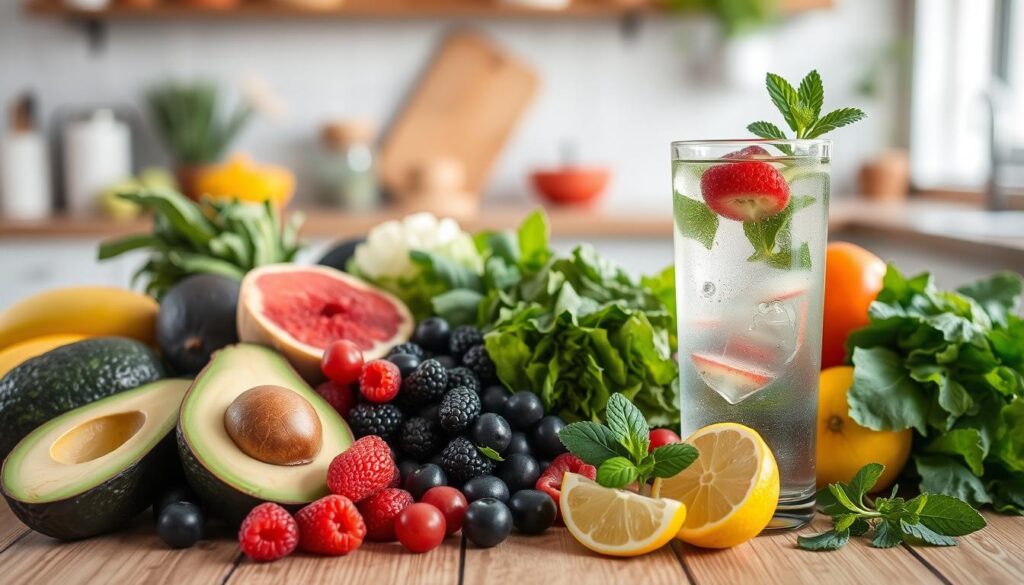Losing lower belly fat is tough but doable. Too much belly fat is not just ugly. It also makes you sick, raising your risk of diabetes and heart disease.
You can’t just lose fat from one spot. But you can lose fat all over. This makes your belly look smaller. Eating right, exercising smart, and changing your lifestyle can help you lose fat and feel better.
Key Takeaways
- Excess belly fat, especially visceral fat, is a major risk factor for chronic health issues.
- Creating a calorie deficit through a combination of diet and exercise is crucial for fat loss.
- Increasing protein intake and reducing sugar consumption can help target abdominal fat.
- Incorporating both cardio and strength training exercises can effectively reduce belly fat.
- Stress management and lifestyle changes like adequate sleep and hydration can support fat loss efforts.
Understanding Different Types of Belly Fat
There are two main types of belly fat: subcutaneous and visceral. Knowing the difference is key to losing belly fat. This knowledge helps in visceral fat reduction, hormonal belly fat management, and metabolic belly fat loss.
Subcutaneous vs Visceral Fat
Subcutaneous fat is just under the skin. It’s the fat you can pinch and see. This fat is less harmful to your health.
Visceral fat, however, wraps around your organs deep inside. It’s the more dangerous type. It raises the risk of many health problems.
Why Belly Fat is Dangerous
Too much belly fat, especially visceral, is bad. Visceral fat increases the risk of insulin resistance, type 2 diabetes, and heart disease. It also leads to inflammation, causing chronic conditions.
The Role of Hormones in Fat Storage
Hormones affect how your body stores fat, especially around the belly. Stress hormones like cortisol can cause hormonal belly fat. Hormone imbalances make losing metabolic belly fat harder.
| Characteristic | Subcutaneous Fat | Visceral Fat |
|---|---|---|
| Location | Under the skin | Surrounding internal organs |
| Health Risks | Lower risk of health issues | Higher risk of insulin resistance, type 2 diabetes, heart disease, and certain cancers |
| Hormonal Influence | Less impacted by hormones | More influenced by hormones like cortisol, estrogen, and testosterone |
| Appearance | Visible and can be pinched | Not easily visible, deeper in the abdomen |
Knowing the difference between subcutaneous and visceral fat helps in losing belly fat. It’s important to tackle the causes of belly fat, like hormonal imbalances or lifestyle factors. This approach leads to a healthier, slimmer midsection.
The Science Behind Loss Lower Belly Fat
Many Americans want to lose belly fat. They spend a lot of money trying. But, they don’t always understand how to do it.
To lose belly fat, you need to burn more calories than you eat. This is true for all fat loss, not just belly fat. Fat burning exercises and targeted fat loss can help, but the body loses fat overall when you eat fewer calories.
HIIT and strength training are great for burning fat. They make your metabolism faster and help you lose fat. Eating right, with enough protein and not too many carbs, also helps with targeted fat loss.
Genetics and hormones affect where you store and lose fat. Some people naturally have more belly fat. This can be due to insulin sensitivity and cortisol levels. Changing your diet, exercise, and lifestyle can help with fat burning exercises and targeted fat loss.
“For significant weight loss, experts recommend at least 225 to 420 minutes of exercise per week in combination with a calorie deficit diet plan.”
In summary, losing belly fat involves eating less and exercising more. Focus on HIIT and strength training. Also, changing your diet and lifestyle can help with targeted fat loss.
| Statistic | Significance |
|---|---|
| Individuals on a low-carbohydrate diet lost an average of 28.9 pounds, compared to 18.7 pounds for those on a low-fat diet over a span of six months. | Low-carb diets can be more effective for fat burning exercises and targeted fat loss. |
| Both low-carb and low-fat diets resulted in a loss of around 2 to 3 pounds of lean tissue along with fat. | Proper nutrition and exercise are crucial to maintain muscle mass during targeted fat loss. |
| Consuming 7 grams of viscous fiber daily can lead to a weight loss of about 0.7 pounds and a reduction of 0.25 inches in waist circumference after 10 weeks. | Fiber-rich foods can support fat burning exercises and targeted fat loss. |
Creating a Caloric Deficit for Fat Loss
To lose weight and get rid of belly fat, you need to eat fewer calories. This means eating less than your body needs to stay the same weight. Your body will then use fat for energy, leading to weight loss.
Calculating Your Daily Calorie Needs
To find out how many calories you should eat, you can use formulas or online tools. These tools look at your age, gender, weight, height, and how active you are. Most adults need between 1,600 to 3,000 calories a day.
Setting Realistic Weight Loss Goals
After figuring out your calorie needs, aim for a moderate calorie deficit of 500-750 calories per day. This can help you lose about 1 pound of fat each week. Losing 1-2 pounds a week is a good pace to keep.
Tracking Your Progress
- Keep an eye on your weight, body measurements, and body fat percentage to see how you’re doing.
- Use a fitness tracker or calorie-counting app to stay on track and make changes when needed.
- Remember, losing weight takes time and effort. Stay consistent and patient.
By eating fewer calories, setting achievable goals, and tracking your progress, you can lose that stubborn belly fat. You’ll be on your way to the body you want.
Essential Nutrition Guidelines for Fat Reduction
Starting a healthy, toned body begins with what you eat. To loss lower belly fat, follow key nutrition tips. A diet full of nutrients is vital for losing weight well.
Eat whole, unprocessed foods first. Lean proteins like chicken, fish, and beans are good. Add colorful fruits and veggies for vitamins and antioxidants. Whole grains like quinoa and oats give you energy.
Don’t eat too much of bad stuff. Avoid sugary drinks and fried foods. Drink water and eat healthy fats from nuts and avocados.
- Aim for 150 minutes per week of moderate-intensity cardio exercise for best results.
- Incorporate two to three strength-training exercise sessions per week to build lean muscle.
- Foods high in soluble fiber, such as flaxseeds and avocado, can help you feel full for longer.
- Consume adequate protein to keep you feeling satisfied, lower hunger hormone levels, and reduce overeating.
Avoid quick fixes for belly fat diet. Real weight loss comes from small, lasting changes. Drink water, eat mindfully, and sleep well. These tips will help you lose lower belly fat and reach your fitness goals.

“Losing 5% to 10% of your body weight can improve blood pressure, blood sugar, cholesterol levels, mobility, and sexual function.”
The Power of Protein in Fighting Belly Fat
Protein is a big help when you want to lose belly fat. Eating more protein can help you lose weight and keep your body strong. Choosing the right protein and eating it at the right time can really help you.
Best Protein Sources for Fat Loss
Lean meats, fish, eggs, and dairy are great for losing belly fat. Legumes and plant-based proteins like quinoa are also good. These foods make you feel full and help you eat fewer calories.
Optimal Protein Timing
Eat protein at every meal and snack. Eating 25-30 grams of protein at each meal can help you lose weight. This keeps your energy up and your metabolism working.
Protein Portions Guide
- Lean meats and fish: 3-4 oz per serving
- Eggs: 2-3 eggs per serving
- Dairy: 1 cup of milk or 1 cup of Greek yogurt
- Legumes: 1/2 cup cooked
- Nuts and seeds: 1 oz (about 2 tablespoons)
- Protein powder: 1-2 scoops
Eating more protein can help you eat fewer calories. This can be a big help in losing belly fat.
“Increasing your protein intake to 30% of your total calories can lead to an average weight loss of 11 pounds over 12 weeks.”
Strategic Exercise Methods for Core Fat Loss
Spot reduction isn’t possible, but some exercises can help strengthen your core. They also boost overall fat loss. By mixing cardio with ab workouts, you can lose fat and get a leaner midsection.
Good core exercises are planks, Russian twists, and bicycle crunches. Add squats and deadlifts to work more muscles and burn more calories. Try to do at least 150 minutes of moderate cardio or 75 minutes of hard cardio each week. Also, do strength training two times a week.
Too much belly fat can raise your risk of heart disease and type 2 diabetes. But, cardio and strength training together can help you reach your fat loss goals.
| Exercise | Benefits | How to Perform |
|---|---|---|
| Plank | Strengthens core, improves posture, and boosts metabolism | Hold a push-up position, engage your core, and hold for 30-60 seconds |
| Russian Twist | Targets obliques, improves balance, and enhances overall core strength | Sit on the floor, lean back slightly, and twist your torso from side to side |
| Bicycle Crunch | Engages both the upper and lower abdominals | Lie on your back, bring your knees in toward your chest, and twist your elbows to meet your knees |
Adding these exercises to your routine, with a healthy diet and lifestyle, can help you reach your core fat loss goals.

HIIT Workouts for Maximum Fat Burning
If you want to lose that hard-to-get lower belly fat, try HIIT workouts. HIIT means short, hard exercises followed by short breaks. It’s great for burning fat and boosting your metabolism.
Sample HIIT Routines
Try a HIIT routine with 30 seconds of burpees and 30 seconds of rest. Mountain climbers are also good, working your core for a minute. Jumping lunges, plank jacks, and Russian twists can make your workouts harder and target different muscles.
Proper Form and Technique
It’s key to do HIIT exercises right to get the best results and stay safe. Make sure you do each move carefully, especially with high-impact ones like box jumps. Good form helps you get the most out of your workouts and avoids pain.
Recovery Guidelines
HIIT is great for fat burning exercises and loss lower belly fat. But, you need to rest well between workouts. Rest for 24-48 hours to avoid overtraining and help with fat loss. This rest lets your muscles heal and your body recharge for the next workout.
Adding HIIT to your routine and following these tips will help you get leaner and lose that lower belly fat.
“HIIT workouts are a game-changer for fat loss. The intense bursts of activity followed by rest periods keep your metabolism revved up, helping you burn more calories even after your workout is over.”
Lifestyle Changes to Support Fat Loss
Getting a healthy body weight is more than just diet and exercise. To help you lose lower belly fat, focus on lifestyle changes. These changes can really help your progress. Good sleep, managing stress, and drinking water are key.
Try to sleep 7-9 hours each night. Good sleep helps control hormones like cortisol. This hormone can lead to belly fat if it’s off balance. Use meditation, yoga, or deep breathing to handle stress and keep cortisol down.
Drink lots of water every day to help with fat loss. Move more by standing or walking often. Quit smoking and drink less alcohol to boost your health and fat loss.

